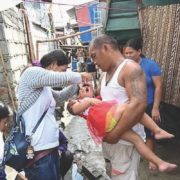
THE Philippine Department of Health (DOH) on Thursday, January 16, said that polio has reached Metro Manila.
According to Health Secretary Francisco Duque III, a 3-year-old boy from Quezon City has been confirmed to have the disease, making him the first case of polio in Metro Manila since the disease returned to the Philippines last year.
This raises the number of polio cases in the country to 16.
Mayor Joy Belmonte told media that Quezon City’s campaign against polio will ramp up, and ordered the city health department to strengthen its surveillance campaign in the area where the patient resides to ensure it would remain an isolated case.
She added that the city government would closely coordinate with the DOH to ensure that the disease is eradicated before it can further spread.
Polio is a highly infectious viral disease that predominantly affects young children and can invade the nervous system and cause paralysis, according to the World Health Organization. Initial symptoms include fever, fatigue, headache, vomiting, stiffness in the neck, and pain in the limbs.
There is no cure for polio, but it can only be prevented by immunization.
Given the number of cases, the DOH is extending its Sabayang Patak Kontra Polio (SPKP) campaign until February to stop the spread of polio in the country.
“I urge all parents and caregivers of children under five years old to take part in the coming SPKP campaign rounds scheduled in your respective areas. Have your children, including those with private physicians or pediatricians, vaccinated with oral polio vaccine by health workers and bakunators,” Duque said.
The DOH, as well as local government units (LGUs), are hoping to accomplish 95% polio coverage in all identified areas for every SPKP round, according to the Philippine Star.
The Acute Flaccid Paralysis (AFP) surveillance will also be intensified, with the DOH now requiring all health facilities to report every case of AFP in any child under 15 years old and collect sufficient stool specimen samples.
“The outbreak must be put to a halt and we can only do this if all our health facilities are achieving the targets for all AFP surveillance indicators, and if every SPKP round, all of the target population are reached and vaccinated. The DOH, its partners and the LGUs will continue to work hand-in-hand to ensure that no child is left behind in our fight against polio,” Duque said.
The disease came back to the country in September last year, 19 years after it was declared polio-free.



